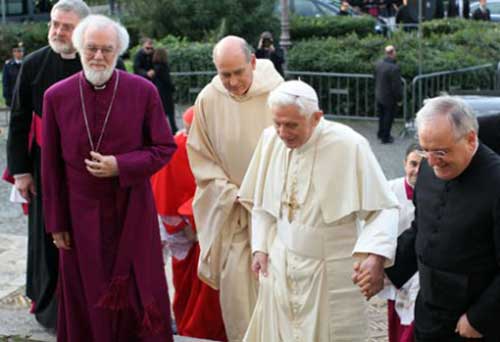The Archbishop of Canterbury addressed the Synod of Bishops in Rome, fifty years after the opening of the Second Vatican Council. He connected contemplation and evangelisation. This comes synchronously as we, here, urge worship, liturgy, the contemplative life to be seen more explicitly centrally to our life and mission as church (also see here).
…To be contemplative as Christ is contemplative is to be open to all the fullness that the Father wishes to pour into our hearts. With our minds made still and ready to receive, with our self-generated fantasies about God and ourselves reduced to silence, we are at last at the point where we may begin to grow. And the face we need to show to our world is the face of a humanity in endless growth towards love, a humanity so delighted and engaged by the glory of what we look towards that we are prepared to embark on a journey without end to find our way more deeply into it, into the heart of the trinitarian life….
In this perspective, contemplation is very far from being just one kind of thing that Christians do: it is the key to prayer, liturgy, art and ethics, the key to the essence of a renewed humanity that is capable of seeing the world and other subjects in the world with freedom – freedom from self-oriented, acquisitive habits and the distorted understanding that comes from them. To put it boldly, contemplation is the only ultimate answer to the unreal and insane world that our financial systems and our advertising culture and our chaotic and unexamined emotions encourage us to inhabit. To learn contemplative practice is to learn what we need so as to live truthfully and honestly and lovingly. It is a deeply revolutionary matter…
Those who know little and care less about the institutions and hierarchies of the Church these days are often attracted and challenged by lives that exhibit something of this. It is the new and renewed religious communities that most effectively reach out to those who have never known belief or who have abandoned it as empty and stale. When the Christian history of our age is written especially, though not only, as regards Europe and North America—we shall see how central and vital was the witness of places like Taizé or Bose, but also of more traditional communities that have become focal points for the exploration of a humanity broader and deeper than social habit encourages. And the great spiritual networks, Sant’ Egidio, the Focolare, Communione e Liberazione, these too show the same phenomenon; they make space for a profounder human vision because in their various ways all of them offer a discipline of personal and common life that is about letting the reality of Jesus come alive in us….
The whole speech is worth close reading.
In seeking for a photo to go with this post, I quickly spotted the one I have placed above. It is from an article when the Archbishop of Canterbury was invited to address the synod. The photo is at a celebration marking the 1,000th anniversary of the founding of the Camaldolese Order. Camaldolese monks and nuns live and pray at the Church of St Gregory and have an active programme of ecumenical contacts. Pope Gregory the Great sent St Augustine of Canterbury and his fellow monks to evangelise England in 597 from this Church of St Gregory on the Caelian Hill in Rome.
I have a particular affection for the Camaldolese, and the monk in the above photo was the one who showed us around Camaldoli.




Thanks Bosco!
The speech reads as an endorsement for the petition changing the mission statement.
Yes, 🙂 Blessings.